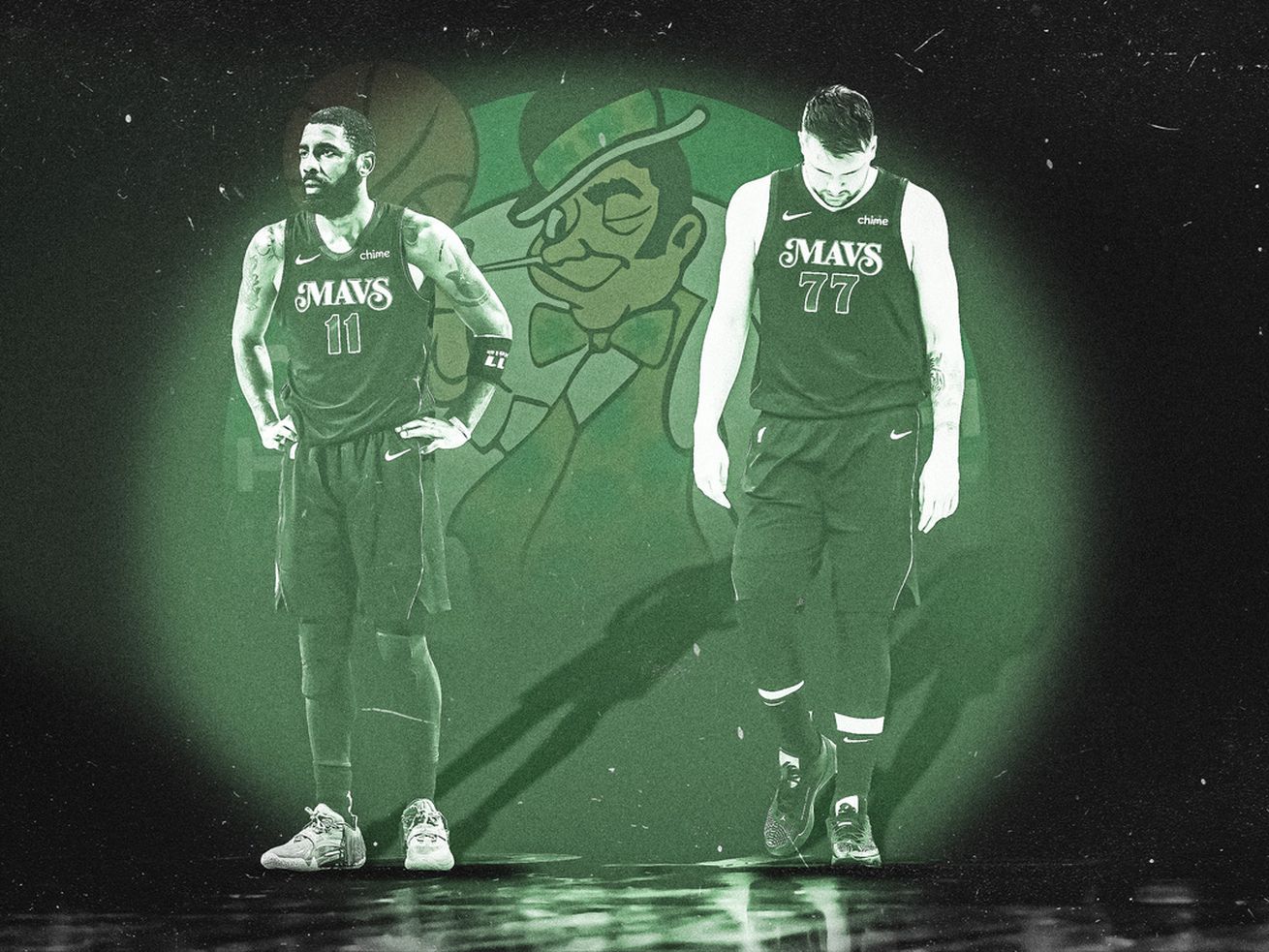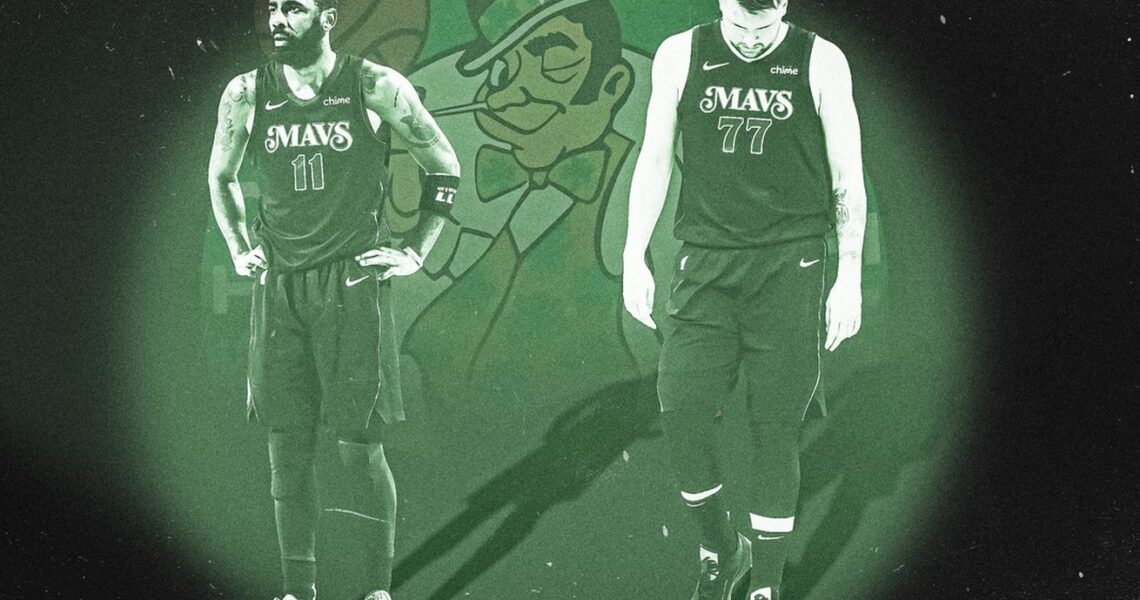
Dallas’s two biggest stars are also Boston’s two biggest targets. The Mavericks can’t win unless they find a way to offer more resistance.
After the Boston Celtics ran away from the Dallas Mavericks in Game 1 of the NBA Finals, most will (justifiably) cite Joe Mazzulla’s defensive game plan as the primary reason this series opener shook out the way it did. Dallas made zero corner 3s and converted zero lobs, which essentially means that it looked nothing like the steady juggernaut that downed three of the Western Conference’s top four seeds on its way to basketball’s preeminent stage.
Luka Doncic finished with 30 points (on 26 shots) and just one assist in Game 1. His team had only nine assists total, leading to its least efficient outing of the playoffs. But everything that happened on the other end felt more problematic in a way that could linger throughout the entire Finals. “I don’t really think the offense was our problem tonight,” PJ Washington said Thursday. In a lot of ways, he was right.
As connected and physical as the Mavericks have been over the past six weeks, can they restrain one of the most explosive offenses in NBA history?
In Game 1, the Celtics logged 15 isolation plays against single coverage, per Synergy Sports. They generated 1.4 points per possession on them. Dallas switched as often as Boston did, but the most notable difference between both defenses is that one deploys a troupe of incredible individual defenders, and the other has Doncic and Kyrie Irving, two relative weak spots who have no choice but to be involved in actions, now facing an offense that can torture them over and over again.
Unlike all of Dallas’s previous opponents throughout this playoff run—the Clippers with Russell Westbrook, the Thunder with Josh Giddey and Lu Dort, and the Timberwolves with Rudy Gobert and Kyle Anderson—the Celtics have no obvious spot for Doncic or Irving to hide when Boston has the ball. In Game 1, that was never more obvious than when they were hunted relentlessly by Jaylen Brown or Jayson Tatum:
Boston’s two All-Stars looked every bit the part (minus several sloppy Tatum turnovers) by repeatedly beating whoever was in front of them off the dribble and then reading the rotation and spraying a pass out to open shooters. When a guard wasn’t the target, Dereck Lively II, Daniel Gafford, or Maxi Kleber was called to dance on the perimeter, which, more often than not, forced Irving and Doncic (who can’t afford to be in foul trouble) to collapse off the 3-point line and cut off a drive:
None of this should surprise anyone. “I mean, I guess it was to be expected, right?” Kleber told The Ringer after Game 1. “They target like we target. So we just got to make sure to be better in our stance, protect more, and be quicker on our execution. … The execution on the switch has to be better, but also when they attack and get into their drive-and-kick game, that’s when we got to be on high alert and just rotate out quicker to take away easy open threes.”
Coming into the Finals, Tatum and Brown combined to average 23.9 drives per game. On Thursday they drove the ball 34 times, which helped generate 13 more corner three attempts than Dallas’s one. “Their spacing is great and they have a lot of shooters,” Doncic said. “So I think we have to do a better job taking those threes away.”
There were stretches in the third quarter when Dallas did just that, bogging Boston down, coaxing tough pull-up shots, forcing turnovers, and funneling the ball where it wanted it to go. “I think our offense got a little stagnant and it had a lot to do with our spacing,” Tatum said. “They kind of put us into some bad ways on offense which kind of threw off our spacing and slowed us down.”
Doncic got a few key stops out on an island, and the Celtics probably went out of their way a bit too much trying to keep him involved on defense. Boston’s offensive rating in the second half was just 95.7
But by and large, what makes the Celtics so dangerous is the room opponents have no choice but to let them operate in. Get too hung up on taking away their threes and Tatum and Brown will put pressure on the basket. Pretty much everyone on this team can make a play with the ball. They’re all comfortable creating against a hard closeout and can either finish in the paint or identity help and then move it to another shooter. There are no easy ways to make them feel awkward. There are no obvious names to ignore, which means help on Boston’s drives will eventually surrender the very looks they feast on:
Defensive strategies don’t matter if you can’t keep the ball in front of you. A schematic alteration where Dallas opts to either drop the screener’s defender and guard pick-and-rolls 2-on-2, or blitz the ball-handler and squeeze a pass, would be equally problematic and yield just as many three-point chances and tries at the rim. Switching is probably Dallas’s best bet in this series, even with mismatches all over the floor, including some that can potentially leave them vulnerable on the boards:
Jason Kidd tried a bunch of stuff in Game 1. He even turned to a zone with Kleber—who finished -15 in 19 minutes—at the five. It didn’t work:
The Celtics turned to some tried and true concepts that Dallas couldn’t handle. Below, Tatum sets a ball screen and then rolls Irving to the nail, where it’s virtually impossible to send a double team or even show much help off the other four shooters:
Boston ran the same play on the next possession and instead of entering the ball to Irving, White pinged it to Porzingis for three, with Doncic not even trying to run his former teammate off the line:
The Celtics also made Doncic work off the ball. Here’s White setting a pindown for Tatum. The Mavs are slow to switch, so Tatum spots the hesitation and rifles the ball back to White for a corner three. “We just have to communicate a lot better and just be better in our principles defensively,” Gafford said after the game.
About 30 minutes after the final buzzer, Lively II stood at his locker in a towel and slides. As a crowd of cameras started to approach, he turned his head out of surprise and smiled. “Oh shit.” Tim Hardaway Jr. a few lockers over, laughed. “Welcome to the league, my boy!”
The rookie sat down and answered questions, including one that asked for his thoughts on Dallas’s switching. “I feel like it was part of our game plan,” he said. “Make them swing the ball, make them feel uncomfortable, make them try to put the ball on the floor so they’re not just spotting up shooting. I feel like we did that better in the second half than the first half. So as soon as we did that, we came back in the game. So we know what we need to do in the next game.”
Lively had two points and five fouls in his Finals debut. More importantly, as arguably Dallas’s top defender, he’ll need to do a better job contesting three-point shots while covering for his dynamic starting backcourt. Against Boston, Doncic and Irving will need all the support they can get.
“I think this is the best team in the NBA and they are good for a reason,” Kidd said. “They play their style of basketball at a high rate. They generated 27 threes there in the first half, and made I think 11 of them. So we have to be better…Give them credit. They were good tonight. But again, we’ve got to be better.”

